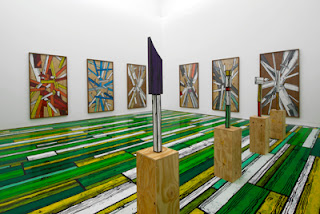My research into Victorian type and industrial Victorian signage has made me want to develop a typeface for the rebranding of Fargo Village. However, I do not want it to be a direct copy of a Victorian typeface, I want it to have aesthetic qualities of an industrial Victorian typeface but I want it to have the a modern overall presence.
Therefore, there are two major influences that I am going to use in the creation of this type.
I found this on the side of a roof down Far Gosfrod Street. It is an origional Victorian sign that once advertised a tobacco company. Ok, so the actual typeface is not well designed, the K looks very awkward and there is a varying width of stroke width on letterforms which I do not think works. However, I quite like the proportions of the type. It is fairly condensed, and I also really like the way that the drop shadow works. It is the drop shadow that gives it its Victorian quality.
The other typeface that I am going to use as influence to develop my typeface is a modern design. It is called Gotham and produced by Hoeffler and Frere Jones. In particular, I am interested in the medium weight letters and numbers.
It is a typeface inspired by the industrial heritage of America- the type constructed out of paint, neon, steel and glass that is seen everywhere in the American Urban landscape. The typeface is straight forward and and simple. The letter forms are non-negotable and have a timeless modern feel to them. Hoeffler and Frere Jones describe the typeface as being "assertive but never imposing, friendly but never folksy, confident but never aloof."
I am going to take inspiration for formation of letterforms from this typeface. The way that letterforms curve, the way that ascenders and decenders attatch to the body of the type, the consistant x height of the type and also the thickness of the type stroke. I want a consistant thickness to all lines constructing the typeface and i want a medium/bold weight of font.
I have also decided that I am only going to produce a capital typeface as my research shows only the use of capital characters in Industrial Victorian signage.
Initial drawings



To develop all of the letters of the typeface I have drawn them all out by hand. This way I have more control over the minute details of each letter form. One of the most difficult aspects to the type design I have found is determining the x height. For the cross bar of the capital A, so that the letterform looks balanced, I have had to bring it below the x height. Also, curves in letters are particularly hard to get right. In my typeface, each curved line differs slightly. Some rounded areas are tighter than others. The third example page of experimentation here shows a drop shadow which does not connect to the letterform and which is illustrated by just one line. The thinking behind this is that I want the drop shadow of the letters to have a more contemparary feel to them than my Industrial Victorian Research. I am attempting to create a drop shadow with a lighter visual presence. Careful consideration has gone into the thickness of the typeface. On this gridded paper, I have determined that the optimum thickness if the cap height is 50mm to be 8mm. The width of the type varies from 30mm to 40mm. Generally, the type is 35mm in width. This gives the type an overall condensed feel that I am after (inspired by the Victorian type I found on the roof on Far Gosford Street). Some of the generally wider letters including the G and the A look awkward with a width of 35mm, hence the 5mm variance. Also, letterforms such as the L do not have the slight condensed feel that the other letterforms have when designed with a 35mm width, hence the 30mm value to the width of a few of the letterforms.






































